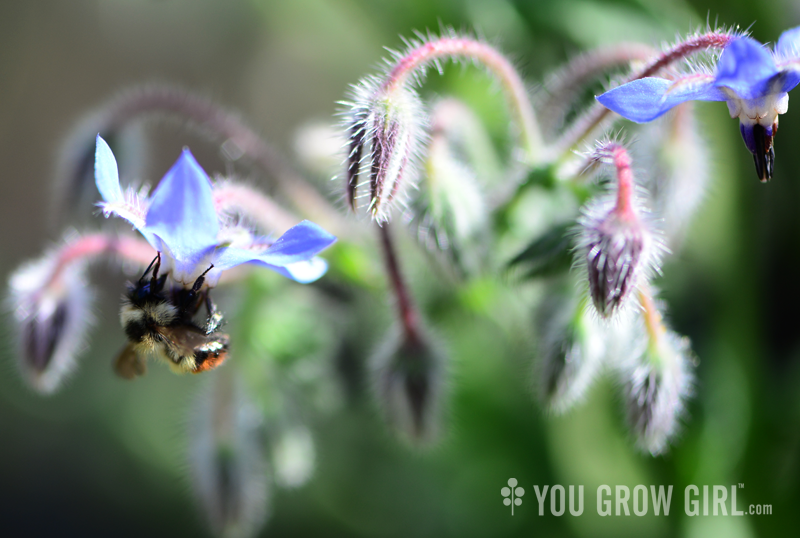
I’ve been growing borage (Borago officinalis) for almost as long as I’ve been a gardener, but when I look back, I can’t recall why I started growing it in the first place. Borage is an unpleasantly prickly if not painful plant. It grows scraggly and too tall in my well-cared-for soil and relies on neighbouring plants to be held up, often shading them out in the process. Over the last few years, as the soil in this garden has improved, I’ve found myself playing host to increasingly monstrous plants, the likes of which I have never seen before. They are dense, with thick stems that lead off to a multitude of branches. And still, they do not stand up well.
In the right location borage will reproduce like crazy, putting out loads of seedlings every spring. It prefers the sun, but will grow in the shade. It will grow in poor, dry soil or poor, moist soil alike. It will grow just about anywhere, although, the one place I have never found it to do particularly well is in a pot. You’ll need a really big, deep one for it to thrive. Probably the thing I dislike most about borage are the prickly leaves. I am allergy-prone, especially to plants with hairy leaves. Oh, how borage leaves make me itch. They are especially itchy on a hot summer night when my arms are bare and I am hustling to get the garden watered before dark. That combination of bare arms, moisture, and rushed work results in a breakout of hives up and down my arms. Borage is almost always the culprit. And still I continue to grow it.
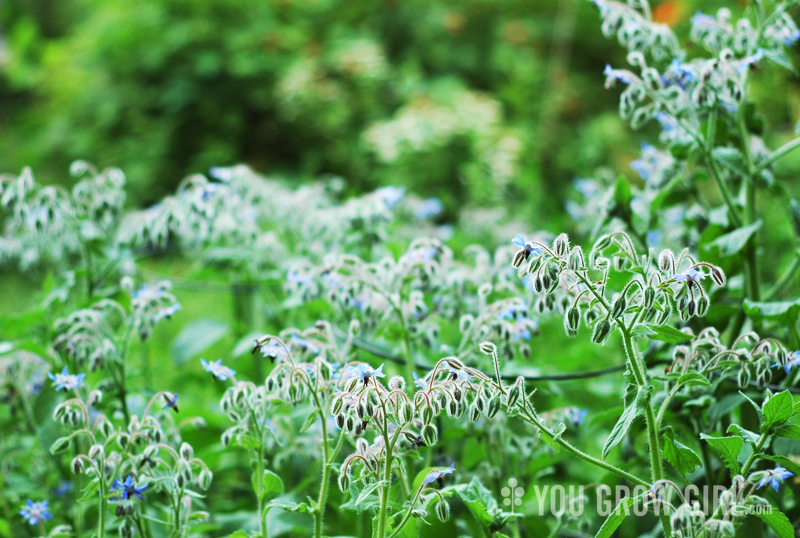
Back when I was starting out as a gardener, I was merely fumbling along, growing what I liked or could eat. I didn’t know the merits of borage as a valuable, long-season source of pollen for bumble bees, nor did I know about or understand the significance of growing for pollinators in the first place. So when did I first add borage to my gardens, and why did I choose it?
Chances are good that I acquired it on sale or in trade. And once I started growing it, I never stopped. I brought it along with me from garden to garden. It would be years before I came to fully discover and appreciate all that this plant offers, and yet, prior to my education, I brought it with me anyway. Perhaps I got hooked on its looks. Yes, borage is scraggly and pernicious, but it also features a rather architectural growth habit of grey/blue leaves along the stems, graced with clusters of the most beautiful, corn blue or white), star-shaped flowers. Before I knew the importance of bees in a functioning, healthy ecosystem, I appreciated their presence in the garden. Blooming borage calls bees to a garden in droves.
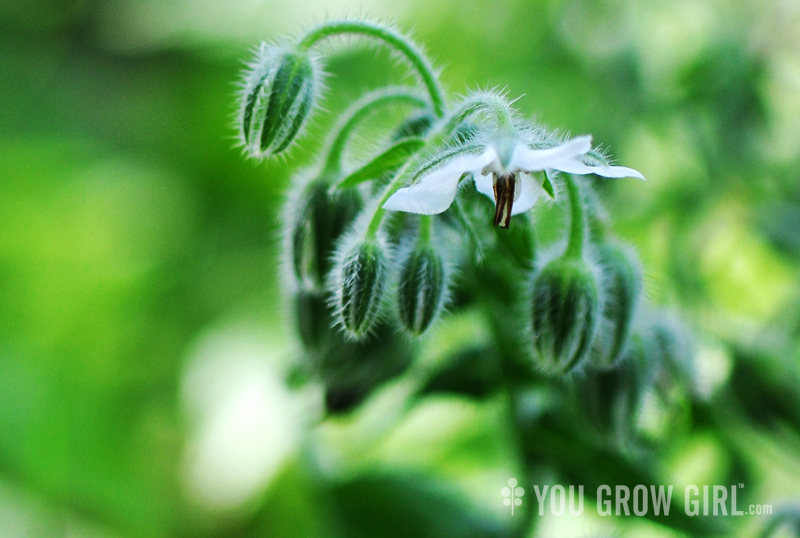
White borage.
Eating Borage
Borage is edible, but comes with some notes of caution. The plant is loaded with vitamins and minerals including potassium, iron, calcium, vitamins a, c, and b3 [Source: USDA Nutrition Database]. However, it is also said to contain alkaloids (pyrrolizidine) that can be harmful to the liver if consummed in large amounts and it is suggested that those with compromised livers should avoid it entirely [Source: Plants for a Future]. For this reason, I personally consider it an occasional food and not an everyday meal. I also stick to using younger leaves. On the plus side, the leaves carry other healthful, medicinal uses, most notably they are highly mucilaginous, which is great for soothing and cooling inflamed gut conditions. It is for this soothing quality that I distill it and use the hydrosol in one of my mixes for cooling inflamed or overheated summer skin. It is also said to be mildly sedative (“Borage for courage!”) and is sometimes used as an adrenal tonic [See Penn State Plant Sciences and others].
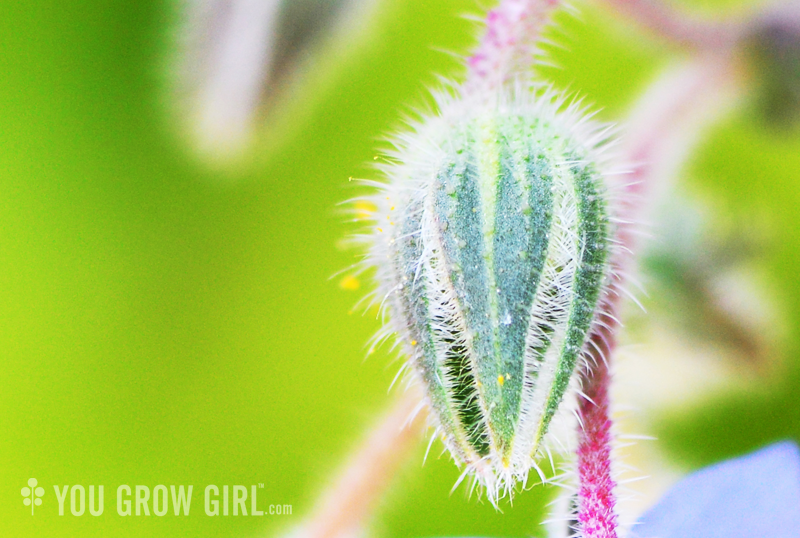
When it comes to eatability, it is the flowers that gardeners turn to first. Unlike the leaves, they are inviting: soft and delicate on the tongue with a hint of cucumber flavour. They do not keep well, save for freezing in water, and are really best used during their season. From a gardening friend (Julianna), I learned to toss the hairless new sprouts into salads. Next, I took to chopping up the prickly leaves and frying them in a batter with other herbs. However, fritters are a nice treat, but hardly count as a healthful staple, and I found that most of the plants I grew ended up in the compost pile (or made into a fertilizer tea) and not on my plate. I tried sautéing the prickly leaves, and while that was doable, I just couldn’t be bothered.
Jump ahead to 2018. Perhaps it was due to the sheer volume of the plant in my garden this year (again, I allow so much to grow for the pollinators and insects that rely on it), but I decided once and for all to figure out how to best work borage into my diet, not as a special treat, but as a healthy green. I knew that it was much-loved in some regional Italian cooking and so I began my research there. Primarily what I found in digging through cookbooks was borage leaf used as a pasta stuffing or cooked with eggs, such as a frittata. In those preparations, the leaf is boiled or blanched in salted water to render the prickles inert. In my experimentation, I have found this to be the most effective and best way to use the greens. Sautéing with water, fat, acid, and a little salt is also recommended, but requires more water and much longer cooking than other prickly greens like stinging nettle to subdue the prickliness. I have heard of borage leaf pesto, but with so many other leafy options in my garden, I haven’t bothered to try it yet. My most successful experiment has been borage soup and I have made and enjoyed various incarnations of it many times now. My next post will be a recipe that I developed and wrote up.
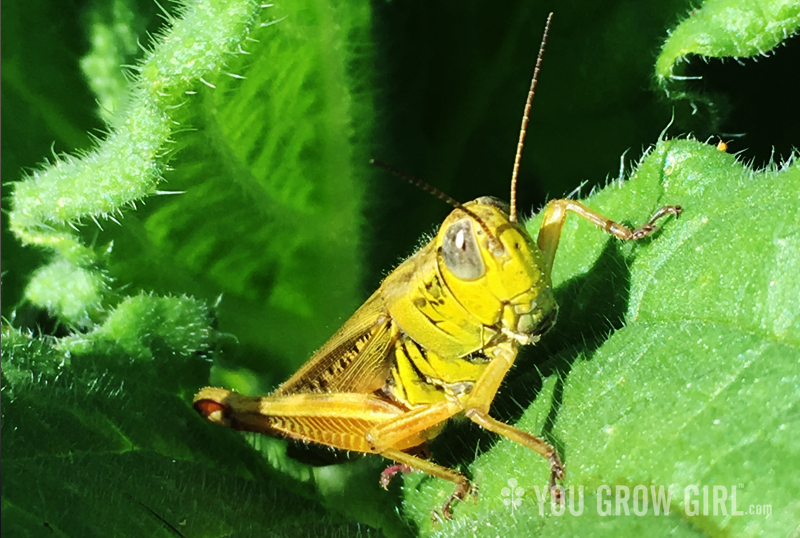
This year I discovered that grasshoppers love borage. I often found them congregating on the plant. Buds and leaves were clipped where they had been. Fortunately, I have plenty of borage to share and there are very few critters interested in eating it.
Borage Harvesting Tips
- When harvesting to eat, choose the most tender, newest growth.
- Wear gloves when harvesting, especially if you are allergy-prone like me.
- Stems are edible too, and I find they can be better than the leaves. However, they are best prepared with the prickles removed ahead of cooking. I have tried various peelers, but find that running a paring knife down the length of the stems is the easiest method of scraping the prickles off.
Unfortunately, borage’s season has just ended here in Toronto. The killing frost came last weekend and took the last of my borage plants with it. However, now that I’ve come to really know and love the plant on another level, I am really looking forward to further experimentation next year. Have you experimented with borage? What have been your best and worst results?
I too gave way too much borage and most of it ends up in the compost. And in Southern California it’s a year round plant. I do love the flowers to eat and as garnishes. Sometimes I use the tender leaves in banh mi sandwiches. I’m looking forward to your borage soup recipe.
Thank you for writing this. I also have borage in my garden. Each year I just let selected seedlings mature along the garden edges, I used to collect seed but don’t need to anymore. I guessed it was helping deter some of the wildlife from digging in my garden- squirrels particularly bothersome- because the patch of my garden that had borage, had no squirrel holes that spring. I’ve occasionally picked the pretty flowers for salads, but otherwise never thought to eat it. I’m glad of your suggestions and will definitely keep this plant going for the bees!
That’s a great point about deterring the squirrels.
I LOVE this post. I am such a fan of borage for all the same reasons. I eagerly await your recipe. Thank you!
My first memory of using Borage was in a punch. It has a mild cucumber-y flavor, so I steeped leaves and stalks in white grape and apple juice overnight, then served it over frozen peach slices with its flowers and a few Rosemary sprigs on top for garnish. I bet this would be great with white wine too!
I first planted borage as it was recommended along with marigolds(knew that) petunias(don’t know why) as the perfect planting companion to growing great tomatoes. The borage I think because it draws bumblebees, like you point out, in droves, so I guess while they’re there they move over to the tomato as a charitable gesture? I am now ruthless about pulling them out because they will take over a garden, but I still leave way too many because I love how long they bloom for, giving pollinators an extended season of food. The blue flowers are just as gorgeous as the prickly foliage is loathsome. I look forward to your soup recipe!
I had two borage plants this past spring and summer. The seedlings didn’t wait until next year, I’ve dozens of them now! I had to move the bed they were in and seeds moved with the soil, and I’m pulling the babies like crazy!
Most are in a disused area, so they can stay.
I absolutely love the flowers. I can’t stand the earwigs that sleep in forming seed pods though!
Borage has been a favorite garden herb -yes, it is mildly invasive- as the bees love it and the little flowers look so beautiful pressed into fresh cheeses! You can pluck just the flower off the sepals and use them as salad decorations, cheese additions, etc. AND for those of you who have goats, it is excellent for encouraging milk production, along with Comfrey. Enjoy it!!
Love that your wrote an article about Borage! I am madly in love with this plant and it was the first thing I planted in my new garden, at our new place this year! I am in a dry climate, but it is still pretty prolific which mostly I find amusing. They are thankfully easy to pull out if in an unwanted spot and I can now recognize the leaves a mile away and get them early. I have read about a few of the medicinal properties but am super interested like the others in your recipe. Thanks for spotlighting this bee loving plant!
Hi,
I read your article with some what of a smile on my face as I too grew Borage in my back garden for years. And as you experienced it I did too the plant grew everywhere on top of everything. At the start I thought how bad at least the garden isn’t bare but it did damage some of my flowers and shrubs. What I noticed also was that it had spread across garden beds, walls and kerbs. Eventually it was out of control. Last year I tried cutting it back but what I have noticed is it has spread it seeds in more place then I thought and I don’t know how I’m going to stop it entirely in the garden from growing back year on year. If you have any advise on this can you let me know please.
Regards
Chris